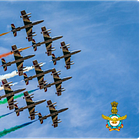Learning from the history of air warfare
After my previous post, some readers have asked me to give a brief history of use of air force wars that resulted in development of our current structure.
As a background, here is a brief history of air warfare and what we learned from the older wars.
Air warfare in WW1
Planes were first used for reconnaissance only, with the pilot looking down from an open cockpit. To eliminate this reconnaissance, they got other pilots to shoot down the plane using guns. The pilots would also drop grenades and small bombs carried in their cockpit in a sack.
Air warfare in World War II
World War II introduced two important concepts - Blitzkrieg and Strategic Bombing.
The German Blitzkrieg was airforce-led bombing (both carpet bombing and strategic bombing) and air transport of troops into enemy territory to create chaos and opening for coordinated attack and capture of enemy territory. Two elements were critical in this - good coordination within the Germans and lack of coordination within the Allies. This was achieved by maintaining radio-based communications while taking out Allied communication mechanisms (radio towers, telegraph lines, road and rail).
Source: Encyclopedia Britannica
The Americans, in contrast, used Strategic bombing. Possibly saddled with reduced supplies, they tried to make each bomb count by taking out specific targets.
Vietnam War
The Vietnam War taught us many lessons about ground support in densely forested areas. The development of A10 Warthogs, Apaches, and Chinooks is a testament to those lessons. From an air force and air warfare perspective, air dominance was not the issue; the ability to support your troops from the air was.
Source: The Air Force in the Vietnam War by Air & Space Forces Association [PDF]
Iraq war 1991
Iraq’s invasion of Kuwait resulted in a globally coordinated effort to end the Iraqi occupation of Kuwait. This was an air-force-led war. Iraq was battle-hardened and well-equipped with anti-air weapons and a battery of missiles. Iraq also had capable radars and monitoring systems.
This war taught us many lessons about the application of air superiority, missile defence, anti-Area access denial, etc. It brought in satellite intel, GPS navigation, terrain reading, precision targeting, etc., in missiles. It also highlighted the importance of stealth.
Armenia-Azerbaijan / Russia-Ukraine / Israel-Hamas war
These wars marked the use of drones for reconnaissance and attack. It also brought to the fore the need for MIRV/MARV missile systems. It also highlighted the use of missile defence systems like Iron dome. It tested out saturation attack, hypersonics, etc.
Future Wars
I have written about some scenarios for future air warfare and the concept of Manned- Unmanned Teaming has lot of possibilities. You can read the previous post here:









